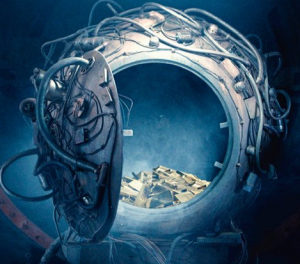
How the Finite Speed of Light Allows Us to Look Back in Time
Traveling back in time is impossible due to the fact that it would violate the law of causality. The famous grandfather paradox, for example, postulates that, if you travelled back in time and killed your grandfather, you would never have been born, so you could never have gone back in time and done it in the first place.Looking back in time, however, is something you do every time your eyes are open. Everything that we see is due to light and light has a finite speed. Absolutely nothing in the Universe can travel faster than light, which travels at a speedy 186,000 miles (300,000 km) per second. This means that everything you see is as it was at the time light left that object whether reflected or directly from a light source.
Here on Earth, an extremely small place in the Universe, it is not possible to provide some practical examples of how backwards time travel works. To provide some examples which most people can relate to, let's take a look up at the night sky.
The moon is approximately 235,000 miles (380,000 km) away. This means that it takes light 1.3 seconds to bridge the gap between the moon and Earth. Every time you see the moon, you are seeing it as it was 1.3 seconds ago.
Let's use the Sun as an example. This is much, much further away from the moon, being at a mean distance of 93 million miles (150 million km) from Earth. It takes light from the Sun 8 minutes and 20 seconds to reach us. If the Sun suddenly vanished out of existence, it would still be there in the sky for that amount of time after its disappearance.
The stars are another matter. Vastly further away than the Sun, the nearest star to Earth other than our own, is Alpha Centauri, at a distance of 4.3 light-years. This means that it takes light 4.3 years, even at its immense speed, to cross the void all the way to Earth.
Astronomers uses the very fact that, the further away something is, the further we can see back in time. This is how we know so much about the early universe and how things like stars and galaxies form.
The most distant objects in the night sky which can be detected by telescopes are those which have been around for enough time that their light has managed to reach us. These objects are around 13.3 billion light-years away from Earth. Things much further away than that simply aren't visible yet, since their light is still making the unimaginably long journey to us. We have no idea where these distant objects in the night sky are today, since we can only see them where and how they were 13.3 billion years ago.
How to Travel to the Future
We are moving through the fourth dimension, that being time, constantly. However, what if you want to travel to the future ahead of everyone else and see what the world will be like in, say, twenty years from now? Is it possible? In short, yes, it is.When it comes to explaining how time travel to the future works, we need to look to a phenomenon called time dilation, part of Einstein's famous theory of relativity. To put it as simply as possible, time dilation means that, the faster something moves, the more time slows down.
Gravity also exerts forces on time as well as space by speeding things up the closer they are to a gravitational force. A higher gravitational force causes things to orbit an object at a higher speed. The orbital speed of any object, such as a planet or moon, is dictated entirely by the average distance of the object from its primary and the mass of both objects.
The effect becomes particularly extreme with things like black holes. These are dead stars which exert such a strong gravitational force that even light cannot escape the surface. If you were to orbit close to the event horizon (the point of no return at which even light cannot escape), you would be moving around it at such an immense speed that, while the speed of time would not change from your point of view, time would pass much quicker on Earth.
As you move towards the event horizon, your speed will increase and time will move slower. At one point near the event horizon, you would be spinning around it at 0.999 percent of the speed of light. Stay there for one year and, back on Earth, over 22 years will have passed.
Some other relativistic effects that you will experience at this speed is that your mass would increase 22 fold while your length in the direction you're travelling would decrease 22 fold. Of course, since this would not be very good for your health, it is impossible to go too close to such a powerful gravitational source without being ripped apart.
Practical Examples of Time Dilation
The speeding up of time that is time dilation is something that effects something that many of us use regularly – GPS navigation systems.When we use a GPS navigation system, such as those on a TomTom or a high-end smartphone, we need to wait for the device to locate three GPS satellites orbiting the Earth in order to triangulate our position and then guide us along.
GPS satellites, partly in order to reduce the effects of gravitational time dilation, orbit in medium Earth orbit at a distance of 12,550 miles (20,200 km) from the surface and so their orbital speed is lower, being about 8,640 miles (13,900 km) per hour. Objects can only travel slower or faster than their natural orbital velocity by using some method of propulsion.
Because someone on Earth using his or her GPS navigation system is moving relatively slowly, the atomic clocks on board the GPS satellites are running faster than clocks back on Earth. The difference is only a tiny fraction of a second but, in order to keep the GPS network running reliably and accurately, the entire system needs to make allowances for the effects of time dilation and the clocks need to be calibrated accordingly.
Another example of time dilation can be drawn from the International Space Station, which orbits in low Earth orbit at a distance of 250 miles (400 km), far closer than GPS satellites. The orbital speed in low Earth orbit, for example, is between about 15,430 to 17,650 miles (24,800 to 28,400 km) per hour, depending on the exact distance from Earth. Thanks to this speed, ISS personnel also get to enjoy some 15 sunrises and 15 sunsets per 24 hours!
Astronauts on the ISS often stay on board for six months at a time. When they come back to Earth, they are about 0.007 seconds younger than they would have been if they had stayed on the ground. It might not sound like much, but it does prove that time travel to the future does exist, even in practical terms.



